Mandala
Special Offer: How About A Gift Of Art This Christmas?
 Artworks are a unique, inspiring gift for Christmas and we believe our collection is a perfect fit also for Buddhists and Hindu willing to celebrate this grateful event.
Artworks are a unique, inspiring gift for Christmas and we believe our collection is a perfect fit also for Buddhists and Hindu willing to celebrate this grateful event.
Choose your favorite Mask, Mandala or Thangka painting and contact us writing “gift” on your message to receive a special discount.
Love and Blessing
Sunapati Thangka School and Shop
traditionalartofnepal.com
To reach the Christmas tree on time we recommend to order your artwork for overseas delivery no later than 10th December 2014.
Follow traditionalartofnepal.com on WordPress.com
Brief Introduction To Thangka and Mandala Paintings
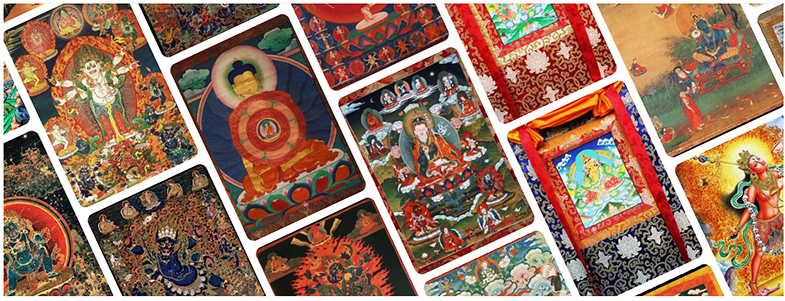
Thangka (also known as Pauva or Pauba पौभा in Nepali) is a painting usually illustrating a Buddist mandala or a deity. Unlike other painting, a thangka consists of picture painted or embroiled over a cotton cloth and then mounted on a silk frame cover. Although they are delicate in nature, these artworks last a very long time time and retain much of their lustre.
Thangkas served as important teaching and meditating tools. Most of the first artworks depicted the life of the Buddha, various influential lamas and the most relevant deities and bodhisattvas.
The most common subject depicted in the entry of Buddhist monasteries is “The Wheel of Life”, which is a diagram depiction of the Abhidharma teachings and the main concepts of Buddhist doctrine.
The paintings of Buddha Life were painted by lamas and monks in monasteries both in Tibet and Nepal. This knowledge was transmitted to members of the monks families and then spread among lay people and devotees that started thangka art painting schools, especially in the Kathmandu valley.
A thangka painting can be considered as an object of decoration, but its spiritual importance is more relevant, especially for Buddhist monks and scholars who revere it with mystic power accordingly to the deities represented.
Devotional images act as the centerpiece during a ritual or ceremony and are often used as mediums through which one can offer prayers or make requests. Overall, and perhaps most importantly, religious art is used as a meditation tool to help bring one further down the path to enlightenment.
Images of deities can be used as teaching tools when depicting the life (or lives) of the Buddha, describing historical events concerning important Lamas, or retelling myths associated with other deities.
History of Thangka in Nepal
Thangka is a Nepalese art form exported to Tibet after Princess Bhrikuti of Nepal, daughter of King Lichchavi, married Songtsän Gampo, the ruler of Tibet and thus imported the images of Nepalese deities to Tibet. History of thangka Paintings in Nepal began in 11th century A.D. when Buddhists and Hindus began to make illustration of the deities and natural scenes.
Historically, Tibetan and Chinese influence in Nepalese paintings is quite evident in Thangkas.
It was through Nepal that Mahayana Buddhism was introduced into Tibet during reign of Angshuvarma in the seventh century A.D. There was therefore a great demand for religious icons and Buddhist manuscripts for newly built monasteries throughout Tibet.
A number of Buddhist manuscripts were copied in Kathmandu Valley for these monasteries.
The influence of Nepalese art extended till Tibet and even beyond in China in regular order during the thirteenth century. Nepalese artisans were dispatched to the courts of Chinese emperors at their request to perform their workmanship and impart expert knowledge. The exemplary contribution made by the artisans of Nepal, specially by the Nepalese innovator and architect Araniko, bear testimony to this fact even today.
From the fifteenth century onwards, brighter colours gradually began to appear in Nepalese Thangka. Because of the growing importance of the Tantric cult, various aspects of Shiva and Shakti were painted in conventional poses. Mahakala, Manjushri, White Tara, Chenrezig and other deities were equally popular and so were also frequently represented in Thanka / Thangka paintings of later dates.
As Tantrism embodies the ideas of esoteric power, magic forces, and a great variety of symbols, strong emphasis is laid on the female element and sexuality in the representation of Dakinis and female Goddesses.
Realizing the great demand for religious icons in Tibet, Nepalese artists, along with monks and traders, took with them from Nepal not only metal sculptures but also a number of Buddhist manuscripts. To better fulfill the ever – increasing demand Nepalese artists initiated a new type of religious painting on cloth that could be easily rolled up and carried along with them.
This type of painting became very popular both in Nepal and Tibet and so a new schools of thangka painting evolved as early as the ninth or tenth century and has remained popular to this day.
One of the earliest specimens of Nepalese thangkas dates from the thirteenth century and shows Buddha Amitabha surrounded by Bodhisattva. The Mandala of Vishnu dated 1420 A.D., is another fine example of the painting of this period.
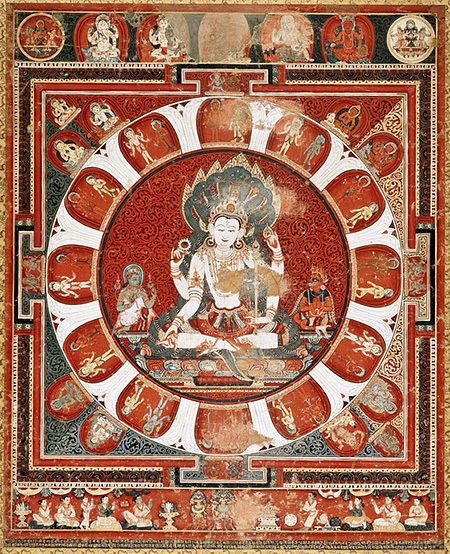
Early Nepalese Thangkas are simple in design and composition. The main deity, a large figure, occupies the central position while surrounded by smaller figures of lesser divinities.
During the reign of Tibetan Dharma King Trisong Duetsen the Tibetan masters refined their already well developed arts through research and studies of different country’s tradition.
Thanka painting’s lining and measurement, costumes, implementations and ornaments are mostly based on Indian styles. The drawing of figures are based on Nepalese style and the background landscapes are based on Chinese style.
Thus, Thangka paintings became a unique and distinctive art.
Thangkas are produced mostly in the northern Himalayan regions among the Newari, Lamas, Gurung and Tamang communities.
Entire families belonging to these communities have preserved this art for generations, which provide today substantial employment opportunities for many people.
Mandala: Sacred Geometry and Healing Art
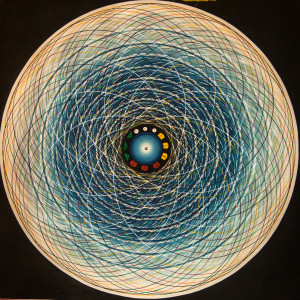 The word mandala is of Hindu origin and is derived from the root ‘manda’, which means essence, and the suffix ‘la’, meaning container.
The word mandala is of Hindu origin and is derived from the root ‘manda’, which means essence, and the suffix ‘la’, meaning container.
Mandala is a term that appears on a chapter of the Rig Veda, a collection of mantras or hymns chanted in Vedic ceremonies. The universe was believed to originate from these mantras, whose sacred sounds contained the genetic patterns of beings and things. This is the reason why it is possible to define “mandala” as a world-model.
In fact mandalas usually represent sacred places which, by their very presence in the world, remind a viewer of the immanence of sanctity in the universe and its potential in his or her self.
Generally speaking mandala is a term for any geometric symbol that represents the cosmic energy in a metaphysical or symbolic matter.
Mandala Buddhist Art
Among the many traditions of Buddhist art the three areas where the Tibetans have made the most significant contributions are mandalas, images of deities and portraiture. In the context of the Buddhist path the purpose of a mandala is to put an end to human suffering, to attain enlightenment and a correct view of reality. It is a mean to discover divinity by the realization that it resides within our own self.
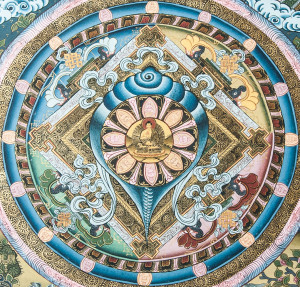 In Tibetan Buddhism mandalas are used for meditation and their specific designs reminding the practitioner of important guiding principle.
In Tibetan Buddhism mandalas are used for meditation and their specific designs reminding the practitioner of important guiding principle.
In fact it is used as visual aid for concentration and meditation leading to the attainment of insights and to activation of forces culminating in “Siddhi”, term used by tantric buddhism doctrine to define special psychic powers.
In its most common form, the mandala appears as a series of concentric circles. Each mandala has its own resident deity housed in the square structure situated concentrically within these circles. Its perfect square shape indicates that the absolute space of wisdom is without aberration. This square structure has four elaborate gates. These four doors symbolize the bringing together of the four boundless thoughts namely – loving kindness, compassion, sympathy, and equanimity. Each of these gateways is adorned with bells, garlands and other decorative items.
This square form defines the architecture of the mandala described as a four-sided palace or temple.
A palace because it is the residence of the presiding deity of the mandala, a temple because it contains the essence of the Buddha.
Mandala Healing Art
Painting mandalas isn’t an activity done merely in religious contexts.
It’s an art for everybody. And it’s a very effective Therapeutic Art !
Carl Gustav Jung introduced the Eastern concept of the mandala to Western thought and believed this symbol is a representation of the individuality and a reflection of the Self.
According to Jung, mandalas symbolize “a safe refuge of inner reconciliation and wholeness.”
The creative process of making mandalas helps to revisit the universal experience embodied in the circle and, as Jung found, helps us to experience and reflect on the essence of who we are in the here and now.
Not only are Mandalas very healing to paint but they radiate healing energy.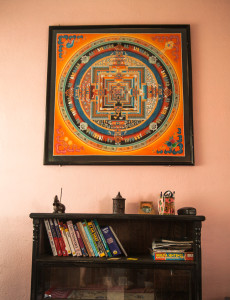
In fact when you have such a mandala in your house, its presence creates a powerful field of energy.
That is why we suggest our customers to place their mandala in a room where they spend five or more hours each day.
This could be your bedroom, your office or your living room.
If you are travelling in Nepal and you are willing to learn how to paint beautiful thangka and mandala paintings feel free to send us a message or contact us using your favorite social media:
Facebook
Twitter
Instagram
Sunapati Thanka Painting School
How To Order
- Browse our catalog and choose your favorite design.
- Select your preferred size and quality to check the price.
- Click on “Product Inquiry” to send us a message and we will check if we the artwork is immediately available. If not we will make it for you.
- Use the cart page to calculate the shipping cost by selecting your country.
- Once we receive your order we will start creating the artwork according to your preferences and provide you with updates and images upon your request.
We strive to ensure a smooth shopping experience with our assistance. We also welcome commissions of custom designs of thangkas, masks and mandalas.
Shipping and Payments
We offer trusted shipping options to ensure your purchases arrive in perfect condition, and delivered in 5 to 10 working days worldwide. We accept PayPal, debit/credit cards and bank wire transfer services.
About Our Community
We live in Changunarayan, a UNESCO heritage site located on a forested hill overlooking Bhaktapur and the Kathmandu valley. You are welcome to visit our art school and meet our community of artists and artisans.
Learn More About Our Thangka School And Workshops
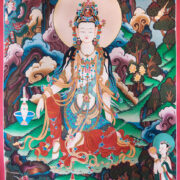 Quan Yin Thangka
Quan Yin Thangka 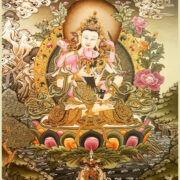 Vajrasattva
Vajrasattva 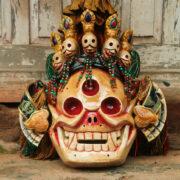 Citipati Mask
Citipati Mask 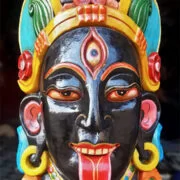 Goddess Kali Mask
Goddess Kali Mask 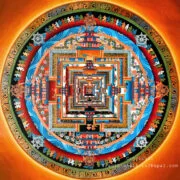 Kalachakra Mandala
Kalachakra Mandala 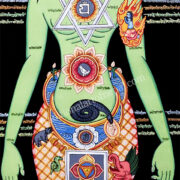 Chakraman Yogi
Chakraman Yogi 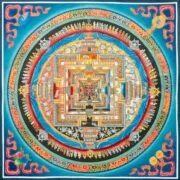 Kalachakra Mandala Auspicious Symbols
Kalachakra Mandala Auspicious Symbols  Universe Om Mandala
Universe Om Mandala 